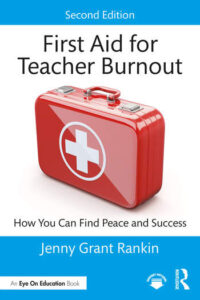A Fresh Look at First Aid for Teacher Burnout
Educator and Psychology Today columnist Jenny Rankin’s 2017 book First Aid for Teacher Burnout was a bestseller. What advice does she have for us in COVID times?
By Jenny Grant Rankin, Ph.D.

Then COVID hit, and things got even worse. Fortunately, as teachers applied different approaches to thriving amid changing conditions, it became clear which strategies gave teachers the best shot at happiness and sustainability in this COVID Era.
What Stayed the Same
Teachers’ work hours remained consistent throughout the pandemic’s different phases, but time spent on different activities shifted. For example, teacher’s saw a massive reduction in average instructional time but an increase in time spent in other areas. “Teachers filled the reduced instructional time with activities that would support the new challenges placed on them” (Jones et al., 2022, p 10).
Teachers surveyed around the world during the pandemic cited educational (e.g., excessive work volume and overstimulation), environmental, student, technological, and administrative reasons for burnout (Doghonadze, 2021), just as they did prior to 2020. Another study of 1,000 former public school teachers in the midst of the pandemic revealed that the top reasons for leaving teaching were the same both before and during the pandemic (Diliberti, Schwartz, & Grant, 2021).
What Changed
One third of teachers are now likely to leave the profession, and those who stay weather growing workloads and express reduced levels of job satisfaction (Hanover Research, 2021).
Over 1,000 teachers surveyed specifically about burnout in spring of 2020 (Hamilton et al., 2020), fall of 2020 (Kaufman et al., 2020), and spring of 2021 (Kaufman et al., 2021) indicated they were significantly more likely to experience burnout by spring of 2021 than they were one year prior.
2020 surveys also revealed that while teachers’ overall feelings (e.g., enthusiastic vs. stressed) had not changed significantly during the pandemic, their feelings during specific professional activities did undergo changes. For example, when teachers were surveyed continually from fall of 2019 to May of 2020, “Pre-COVID meetings with administrators were associated with higher levels of negative [feelings], but post-COVID meetings with administrators were associated with lower levels of negative [feelings]” (Jones et al., 2022, p 9).
Although many tough obstacles come with the territory of being a teacher (a reason teachers will always be heroes), and some obstacles fluctuate over time, there are strategies teachers find to be consistently powerful amid difficult and changing terrain. Though there are many, one major one follows.
Slashing for Sustainability
In the midst of a storm – which is how teaching can often feel – it is hard to focus on more than what is directly in front of us: that next minute, that next deadline, that next emergency. But such survival mode is not sustainable.
Too often teachers are only encouraged to apply coping strategies. Tactics like mindfulness and meditation are definitely helpful and recommended, but the future is far brighter when teachers also slash workload and stress-inducers in major ways. This can sound like something teachers – brilliant as we are – have already done, yet the biggest areas ripe for slashing are often the most overlooked, especially when they are traditional classroom staples. …which brings us to grading.
Grading Revamp
When teachers reduce grading time in favor of planning more engaging lessons, they have fewer behavioral problems, a better time in class, and less academic intervention work. Reducing grading (and all the time-consuming tasks it involves: planning and/or creating the items to be graded, distributing and explaining items, collecting, grading the work, conducting or facilitating grade entry, discussing specific items with students and parents, etc.) also means more personal time to recover from a demanding job.
Even when COVID had us teaching from home, teacher grading time remained relatively unchanged and takes up 20-50% of teachers’ time (not even counting related tasks like prepping and distributing items), making overworked teachers more likely to burn out.
Worldwide, “too much grading” is one of teachers’ three biggest sources of stress (Erberber et al., 2020), and multiple studies reveal teachers hate grading (Educators for Excellence, 2020). Despite this, 92% of teachers agree or strongly agree that they have control over determining how much homework they assign (Erberber et al., 2020). So change is an option.
There are compelling reasons to reduce grading beyond burnout prevention. Experts like Stanford’s Denise Pope call attention to the limited correlation between homework and student achievement (though reading a book of choice at home is beneficial) (Challenge Success, 2020).
Meanwhile, experts like Joe Feldman and Doug Reeves make the case for eliminating homework in the name of equity, since students have such different home environments, and if you must grade they recommend focusing only on most recent work instead of grading everything and averaging scores over time (ASCD, 2020).
In addition – and this can’t be stressed too much – students are less helped by grades than they are by a teacher who is free of burnout and serving up highly-engaging learning time in class.
Thus slashing grading where possible can be highly beneficial to both students and teachers. Teachers owe it to themselves to do a renewed and critical appraisal of what they currently assign and grade, and to winnow down the load wherever possible for the sake of a more sustainable job.
Complex
Each teacher’s burnout triggers and professional circumstances are highly personalized, and solutions in battling burnout are more nuanced than silver bullets. Even so, a well thought-out reduction in grading (whatever that looks like for an individual teacher) is one area where teachers can find large-scale relief from their demanding jobs and more time for the self-care they deserve.
A version of this article was republished at the Psychology Today website.

Rankin formerly served as a White House-honored junior high teacher, junior high school administrator, district administrator, and chief education & research officer. She writes a regular column for Psychology Today and can be reached at www.JennyRankin.com. Find her on MiddleWeb here.































